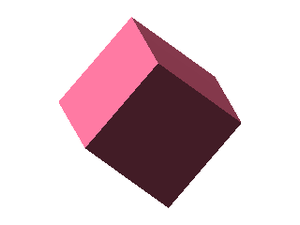Hard cube model: Difference between revisions
FSmallenburg (talk | contribs) (Added some information and a reference) |
FSmallenburg (talk | contribs) m (fixed reference) |
||
| Line 1: | Line 1: | ||
{{stub-general}} | {{stub-general}} | ||
[[Image:cube.png|thumb|right]] | [[Image:cube.png|thumb|right]] | ||
The '''Hard cube model''' models cube-shaped particles interacting purely through excluded-volume interactions. The phase behavior has been studied extensively <ref>[http://dx.doi.org/10.1038/nmat2959 Umang Agarwal and Fernando A. Escobedo "Mesophase behaviour of polyhedral particles", Nature Materials '''10''' pp. 230-235 (2011)]</ref> | The '''Hard cube model''' models cube-shaped particles interacting purely through excluded-volume interactions. The phase behavior has been studied extensively | ||
<ref>[http://dx.doi.org/10.1073/pnas.1211784109 | <ref>[http://dx.doi.org/10.1038/nmat2959 Umang Agarwal and Fernando A. Escobedo "Mesophase behaviour of polyhedral particles", Nature Materials '''10''' pp. 230-235 (2011)]</ref> | ||
Proc. Natl. Acad. Sci. USA '''109''' 17886 (2012)]</ref>. The simple cubic crystal phase has been shown to contain a high number of mobile, delocalized vacancies, similar to those seen in [[Parallel hard cubes]]. | <ref>[http://dx.doi.org/10.1073/pnas.1211784109 F. Smallenburg, L. Filion, M. Marechal, and M. Dijkstra "Vacancy-stabilized crystalline order in hard cubes", Proc. Natl. Acad. Sci. USA '''109''' pp. 17886-17891 (2012)]</ref>. The simple cubic crystal phase has been shown to contain a high number of mobile, delocalized vacancies, similar to those seen in [[Parallel hard cubes]]. | ||
==Implementation== | ==Implementation== | ||
Revision as of 15:23, 28 April 2013

The Hard cube model models cube-shaped particles interacting purely through excluded-volume interactions. The phase behavior has been studied extensively [1] [2]. The simple cubic crystal phase has been shown to contain a high number of mobile, delocalized vacancies, similar to those seen in Parallel hard cubes.
Implementation
Overlaps between cubes can be checked based on the separating axis theorem, which says that if two convex objects are not interpenetrating, there must be an axis for which the projections of the two objects will not overlap. In the case of two convex polyhedral particles, only a finite number of possible separating axes need to be checked: in that case, the possible separating axes are either parallel to a normal of one of the faces of either of the two particles, or perpendicular to the plane spanned by one of the edges of the first particle and one of the edges of the second particle.
For two cubes, the overlap check therefore corresponds to the projection of both shapes onto 15 axes: the three edge vectors of both particles (6 in total), and the axes given by the 9 possible cross products of an edge vector of one cube with an edge vector of the other cube. The particles overlap if and only if the projections of the two particles on all 15 axes overlap as well.
References
Related reading